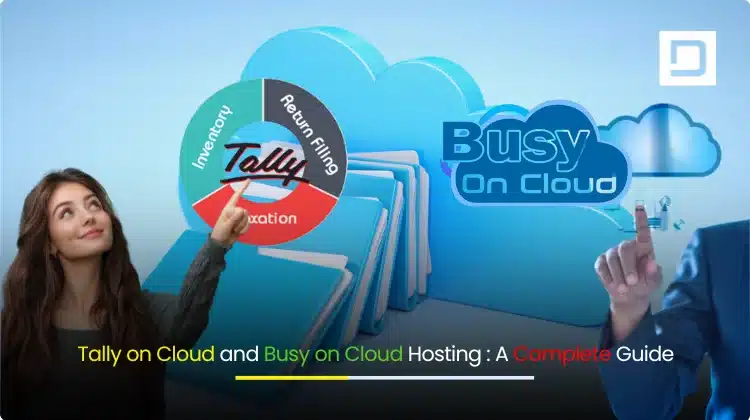Tally on Cloud and Busy on Cloud Hosting: A Complete Guide
Tally on Cloud and Busy on Cloud Hosting are transforming how Indian businesses manage accounting, inventory, and compliance. If you are planning a move from local desktops to a secure cloud environment, this complete guide shows exactly how to evaluate options, calculate costs, plan migration, secure your data, and operate day to day-without jargon or hidden steps. From single-user firms to multi-branch enterprises, you will learn how to make Tally on Cloud and Busy on Cloud Hosting fast, reliable, and compliant with your internal policies and external regulations. The goal is simple: help you use Tally on Cloud and Busy on Cloud Hosting to work from anywhere, close books faster, stay audit-ready, and scale without IT headaches.
Why move Tally and Busy to the cloud now
Every finance team wants access, speed, and certainty. Desktop installations struggle when multiple users need remote access, when branches depend on VPNs, or when you maintain different versions across machines. Cloud hosting centralizes the application, database, backups, and security controls in one managed environment. Users connect through the internet, log in to a secure workspace, and run the licensed copy of Tally or Busy with the same interface they already know.
This change removes the usual friction: no chasing corrupted company files, no late-night patching, no worrying about the laptop that died with last month’s data. It also unlocks new habits: real-time collaboration among accountants, CA firms, and business owners; consistent performance even during peak filing days; and a predictable monthly operating expense that’s easier to budget than sudden hardware purchases.
What “Tally on Cloud” really means
Tally on Cloud is not a modified app. It is your licensed Tally deployed on a high-availability server, accessible through secure remote desktops or HTML5 browsers. You open your browser, authenticate, and work inside a Windows session hosted in the data center. Your company data lives on encrypted disks with scheduled backups. Performance depends on right-sizing CPU, RAM, and storage IOPS and on the quality of your network. With a good provider, opening vouchers, running stock reports, and exporting GST returns feels similar to a strong local PC—only now it scales to more users and branches.
Common scenarios that fit Tally on Cloud
1.Single office with part-time CA access.
2.Multi-branch retailers who need consolidated books.
3.Manufacturers with separate plants and a head office.
4.Accounting firms serving dozens of clients with isolated datasets.
5.Owners who travel and want quick access from hotel Wi-Fi or mobile hotspots.
What “Busy on Cloud Hosting” covers
Busy on Cloud Hosting follows the same model: your licensed Busy software hosted on a managed cloud server. Busy’s strong inventory and taxation features benefit from centralized data, especially when store locations or distributors must enter transactions concurrently. In cloud mode, you can enforce consistent masters, block duplicate entries, and keep audit trails intact. It becomes easier to grant and revoke access for staff or external partners without installing Busy everywhere.
Cloud vs. local: a practical, side-by-side view
Local desktops are simple until they aren’t. They require the right OS, compatible Tally or Busy versions, frequent backups, and some form of remote access that is rarely secure by default. Printers and Excel exports usually work fine, but collaboration becomes messy. A file copy goes missing, someone forgets to back up, or an OS update breaks the app.
Cloud hosting standardizes the environment. The provider maintains OS patches, antivirus, monitoring, snapshots, off-site backups, and role-based access. You log in, work, and log out. Your IT load shrinks to user management and usage governance. If your users already know the application, training time is near zero. The bigger your team and the more dispersed your locations, the more this difference multiplies.
Core benefits you should expect
Anywhere, anytime access
Log in securely from office, home, or while traveling. Branch users no longer wait for files to sync or email backups. CA firms can review ledgers in real time without asking for exports.
Multi-user performance
A correctly sized cloud server with generous IOPS and RAM handles high-concurrency use cases better than a consumer-grade PC. Indexes build faster, reports generate snappier, and locks resolve cleanly.
Security you can actually verify
Data stays in an encrypted environment with access logs, multi-factor authentication, IP allowlisting, and automated backups. If a laptop is lost, your accounting data is still safe in the data center.
Lower time-to-fix
When issues arise, the provider rolls back from snapshots, restores backups, or scales resources. You do not rebuild machines or hunt drivers. Mean time to resolution falls from days to minutes.
Predictable cost model
You pay a monthly or annual fee for hosting plus any additional storage or users. That’s easier to budget than sudden disk failures or server replacements. As usage grows, you scale deliberately.

Tally on Cloud Hosting: architecture that works in the real world
A stable Tally on Cloud setup hinges on a few simple but critical design choices.
Application server.
A Windows Server VM sized for your concurrent users. For light teams, 2–4 vCPU and 8–16 GB RAM work well; for busy teams or CA firms with simultaneous clients, consider 8–16 vCPU and 32–64 GB RAM. Keep enough headroom to run scheduled tasks, antivirus scans, and OS updates without lag.
Storage.
Use SSD storage with healthy IOPS. Tally’s performance depends on quick reads and writes to its data directory. If you run multiple companies or large histories, provision generous SSD storage and consider separate volumes for company data and backups.
Network and session delivery.
Users connect via secure RDP over TLS or browser-based HTML5 gateways. For India users with variable bandwidth, HTML5 options reduce friction because they work through standard HTTPS and avoid complex firewall work. Enforce modern cipher suites and disable weak protocols.
Identity and access.
Attach users to groups with the least privileges necessary. Restrict access by IP ranges for offices or VPNs. Turn on multi-factor authentication. Manage password rotation and account lockout policies.
Backups and snapshots.
Daily encrypted backups to a separate storage tier, plus frequent VM snapshots before major updates. Keep multiple recovery points, including off-site copies. Test restores quarterly to prove recoverability.
Monitoring and alerts.
Watch CPU, RAM, disk queue length, and network latency. Set thresholds that trigger alerts to your provider’s support. A little monitoring eliminates the mystery behind slow report generation.
DR and uptime.
For mission-critical teams, add a warm standby in a second availability zone. Map out RTO and RPO clearly. For many SMEs, a single-zone setup with strong backups is sufficient; as you grow, step up to multi-zone.
Busy on Cloud Hosting: details that keep accountants happy
Busy’s cloud design mirrors Tally’s but brings its own nuances.
Data folder structure.
Keep company folders clearly named and separated to avoid accidental cross-access. Enforce a consistent archival policy at month and quarter close.
Printers and exports.
Make network printers available inside the hosted session. For exports to Excel or PDF, configure a clean download path and a mapped drive to a secure document library so files do not get stranded on the server desktop.
Role-based permissions.
Busy supports granular roles. Use them. Limit who can create masters, approve returns, or delete entries. Strong roles reduce errors, especially in multi-branch teams.
Audit and logs.
Enable detailed logs and preserve them for a defined period that aligns with your compliance policy. Logs are invaluable during internal audits and external reviews.
How licensing works on the cloud
Your existing Tally or Busy licenses remain yours. You host them in a cloud environment rather than on a local machine. Work with your provider to ensure you comply with licensing terms. For multi-user editions, the license server runs on the hosted VM and hands out seats to concurrent users. If you ever move away from the cloud, the license moves with you.
Setting up Tally on Cloud and Busy on Cloud Hosting step by step
- Readiness checklist.
List users, locations, and peak usage times. Note add-ons, custom reports, printing needs, and file exchange patterns with auditors or CA firms. Gather license details and confirm current application versions. - Baseline assessment.
Export a week’s worth of system stats from your heaviest machine if possible: CPU peaks, memory usage, typical company file size, and report runtimes. This helps right-size your first VM. - Choose a region and data residency.
If most users are in India, choose an India region to reduce latency. Confirm where backups and DR copies will live and whether this aligns with your contractual or regulatory obligations. - Prepare identity and access.
Define user groups, MFA methods, password policies, and IP allowlists. Decide who will be administrators and who handles routine user changes. - Provision the environment.
Create the VM with reserved CPU and SSD storage. Harden the OS—disable unnecessary services, enforce TLS, install antivirus/EDR, and apply the latest patches. Configure monitoring agents. - Install and activate the application.
Install Tally or Busy, configure the license server, and add required ODBC or printer drivers. Create a clean folder layout for company data. - Migrate the data.
Copy the latest verified backup. Before making it live, run a validation pass: open recent vouchers, run GST reports, and match totals against the last month’s numbers. - Connect users.
Share the web gateway link or RDP profile. Walk through first login and MFA. Test printing, Excel exports, and PDF generation. Confirm mapped drives and shared folders work as expected. - Run in parallel for a week.
Keep the old environment read-only during this period. Ask users to note any slow screens or unusual prompts. Fix gaps proactively. - Sign off and document.
Record admin steps, backup schedules, and DR procedures. Save them in your internal knowledge base. This prevents single-person dependency.
Security and compliance checklist for finance teams
Encryption at rest and in transit.
Ensure disks are encrypted and that remote sessions use strong TLS. Do not allow legacy cipher suites.
Multi-factor authentication.
SMS, authenticator apps, or hardware keys. Choose one path and make it mandatory for admins and finance leads.
Network controls.
Use IP allowlisting for office ranges and VPN users. Close all unused ports. If possible, put the RDP service behind a gateway or identity-aware proxy.
Least-privilege access.
Separate admin accounts for administration tasks; do not run daily work as admin. Grant file permissions to groups, not individuals.
Patch management.
Keep Windows Server and runtime dependencies up to date. Plan a monthly maintenance window and communicate it.
Backup policy.
Define daily backups, weekly full snapshots, and off-site retention. Test restore procedures regularly. A backup you cannot restore is not a backup.
Audit trails.
Keep logs for access, authentication, application events, and data movement. Align retention with your statutory requirement.
Incident response.
Write a short, practical playbook: who to contact, how to isolate a compromised account, and how to restore from a clean snapshot. Practice it at least once a year.
Performance tuning tips that actually matter
Right-size storage first.
Tally and Busy are sensitive to disk latency. If reports crawl, check storage IOPS before adding CPU.
Keep data tidy.
Archive closed companies and compress old exports. A lean data directory improves scan speeds and backup windows.
Avoid noisy neighbors.
Insist on dedicated or well-isolated resources for your production VM. Bursty shared hosts introduce unpredictable slowdowns.
Schedule tasks smartly.
Run antivirus scans and full backups during off-hours. During peak hours, use incremental backups and real-time protection that respects IO limits.
Measure and iterate.
Track report runtimes, login times, and CPU/disk utilization. After two weeks, adjust VM size with evidence rather than guesswork.
Real-world usage patterns to emulate
Daily opening.
Users log in, open the company, and work as usual. Exports go to a mapped drive linked to your document repository. Backups run after business hours.
Month-end.
Admins add a temporary CPU/RAM bump to speed heavy report runs, stock valuations, or reconciliation exports. After close, scale back to the baseline to save cost.
Auditor collaboration.
Create an auditor role with restricted permissions and time-bound access. Provide a separate folder for requested exports. Revoke access the day the engagement ends.
Employee offboarding.
Disable the user account in cloud identity, rotate shared credentials if any, and review access logs for last activity. Because data never lived on the personal laptop, offboarding remains controlled.
How printing, exports, and integrations work on the cloud
Printing.
Map network or cloud printers inside the remote session. For USB printers, consider a universal print connector or share the device from a small on-prem print server. Test popular formats like A4 invoice templates and delivery challans.
Excel and PDF exports.
Install Microsoft Office or a compatible tool if you need true XLSX exports. Alternatively, export CSV and process in Excel on the user’s machine. Store final PDFs in a centralized document library to keep audit evidence tidy.
Emailing documents.
Use an SMTP relay with per-user authentication to send invoices or statements. This avoids storing mail passwords in the application.
Third-party connectors.
If you use BI tools, expose read-only ODBC connections from a reporting VM that mirrors production data. Never grant production write access to BI tools.
Cost modeling without surprises
Cloud hosting cost includes compute, storage, bandwidth, and managed support. A typical small team might start with a modest VM and 100–200 GB SSD. Add a backup plan with daily snapshots and off-site retention. For 10–20 concurrent users, expect to scale CPU and RAM accordingly. The right provider will offer predictable bundles rather than nickel-and-dime billing.
Hidden cost avoidance comes from fewer site visits, avoided downtime, and reclaimed staff time. When a report that used to take forty minutes now finishes in six, those minutes become hours across the month. When a crashed hard drive becomes a trivial restore from last night’s snapshot, an outage becomes a coffee break.
Migration mistakes to avoid
Skipping a parallel run.
Moving in one shot without a test week risks surprises. A short overlap gives you time to tune and train.
Underestimating storage speed.
CPU is cheap to add. Slow disks are expensive in lost time. Start with fast SSDs.
Ignoring identity hygiene.
Shared admin accounts cause audit pain later. Set up named admins and least-privilege roles from day one.
Forgetting document flows.
If staff rely on desktop folders for exports, map those flows to shared drives or document libraries on day one. Humans work how they’re used to working; help them by mirroring familiar paths.
Letting backups drift.
Verify backup jobs after the first week and after any major configuration change. Backups fail silently if no one looks.
Tally on Cloud for multi-branch operations
Tally shines when branches post daily transactions and head office consolidates. On cloud, you can standardize masters, run periodic syncs, and reconcile quickly. Inter-branch transfers remain consistent, and role controls prevent accidental edits. With the same hosted environment for all branches, onboarding a new branch is as simple as adding users and connecting them to the right company data.
Busy on Cloud Hosting for inventory-heavy businesses
If your business lives or dies on stock accuracy, Busy’s strong inventory features benefit from always-on, centralized access. Store teams enter goods received notes and sales in real time. Head office dashboards show stock positions as they are, not as they were last night. With hosting, you eliminate the lag induced by emailing backups or waiting for VPNs to behave.
High-availability and DR options
Not every organization needs multi-zone redundancy on day one, but plan for it. As the number of users or the criticality of uptime grows, add a warm standby in a second zone. Replicate backups off-site daily. Test failover at least once a year. Document the RTO and RPO clearly so business stakeholders know what to expect during a regional outage.
Support model that keeps finance teams productive
Choose a provider that understands month-end pressure and statutory deadlines. You need quick SLAs, proactive scaling advice in filing weeks, and engineers who speak both IT and accounting. Clear support channels, named account managers, and regular health checks go a long way. A quarterly review should include performance graphs, ticket summaries, and right-sizing recommendations.

Frequently asked questions
Is Tally on Cloud different from TallyPrime?
No. It is your licensed Tally running on a cloud server. The interface and features remain the same; you just access it remotely.
Will my data stay in India?
You can choose India regions and ask for backup and DR details. Confirm data residency at contract time.
How fast does it feel?
With the right VM size and SSD storage, most users experience performance similar to or better than a well-configured desktop.
Can I print to my office printer?
Yes. Map network printers or use a print connector. Always test invoice and e-way bill formats during onboarding.
What about Excel exports?
Enable Excel or export CSV and open locally. Ensure the export path points to a shared, secure folder.
How are backups handled?
Daily encrypted backups with multiple restore points, plus snapshots before major changes. Ask to see a test restore once per quarter.
What happens if a user leaves?
Disable their account immediately. Because data lives on the server, you do not need to retrieve files from personal laptops.
Can auditors access the system?
Yes. Create a limited, time-bound role. Remove it when the audit ends.
Does Busy on Cloud Hosting support barcode printers and POS?
Yes, with proper driver support and network mapping inside the hosted session.
A simple decision framework: are you ready for cloud?
If at least two of the points below resonate, you’re ready for Tally on Cloud or Busy on Cloud Hosting.
Remote users or multiple branches are part of your day-to-day.
Frequent version mismatches or file conflicts keep slowing teams down.
Too much time is spent on backups and restores instead of real work.
During peak filing days, consistent performance is a must.
Stronger security and tighter access control without new hardware are priorities.
Implementation timeline that keeps work moving
Week 1: Discovery and design.
Validate licenses, list users and roles, confirm data residency, and design the VM size. Prepare identity policies and MFA.
Week 2: Provision and pilot.
Spin up the environment, install Tally or Busy, migrate a copy of data, and run a small pilot with power users. Tweak storage and session settings.
Week 3: Parallel run.
Onboard all users, keep the old setup read-only, and run daily work in the cloud. Fix any edge cases—printers, exports, ODBC connections.
Week 4: Go-live and stabilize.
Decommission the old environment, review monitoring, and schedule the first monthly health check.
What to look for in a provider
Transparent pricing, not just teaser rates.
Ability to right-size quickly during filing seasons.
Security features included by default—MFA, encryption, monitoring.
Documented backup and restore with proof through test restores.
India data residency options and clear compliance posture.
Support that understands accounting workflows and deadlines.
Clear offboarding guarantees so you can export everything if you ever move.
How Depex Technologies approaches Tally on Cloud and Busy on Cloud Hosting
Depex Technologies designs cloud environments that favor reliability, security, and day-to-day usability. Your VM is sized from real usage metrics not guesses. Storage stays fast and backups run automatically. Printers are mapped, export folders wired up, and MFA enforced from day one. Policies align with your audit requirements, and every step is documented so your internal team can self-serve where it makes sense. Our support aligns with your calendar: month-end rushes, GST filing windows, and board reporting weeks.
We also go beyond hosting. If you need cloud security reviews, DevOps pipelines, or network optimization between branches, our engineers help you build a foundation that scales as your business grows. For Busy on Cloud Hosting, we bring the same rigor to inventory-heavy environments where accuracy and speed matter daily.
Putting it all together: your next step
Tally on Cloud and Busy on Cloud Hosting give you the best version of the accounting tools you already trust-accessible anywhere, protected by modern security, backed up automatically, and tuned for multi-user speed. The transition is straightforward when you follow a tested plan: assess, right-size, secure, migrate, validate, and iterate.

If you are serious about making your finance operations more resilient and efficient, Contact to Depex Technologies. We will evaluate your current setup, propose a clear architecture and cost model, and move you to a secure cloud environment without disrupting daily work. Whether you need Tally on Cloud, Busy on Cloud Hosting, or a broader strategy that includes cloud security and DevOps, our team is ready to help. Reach out today and let’s build a reliable, scalable accounting backbone for your business.






